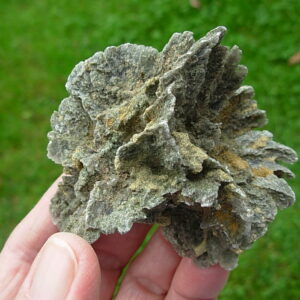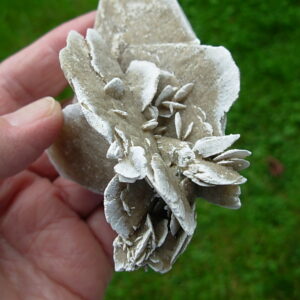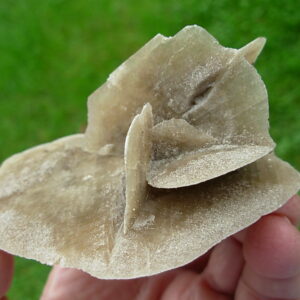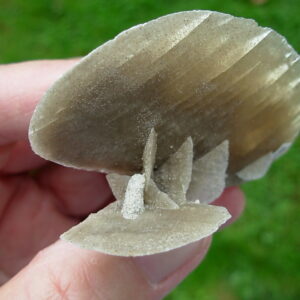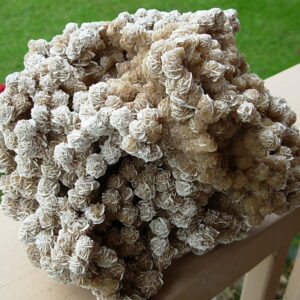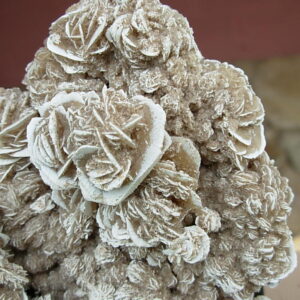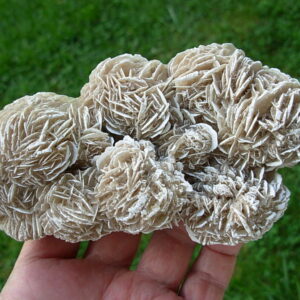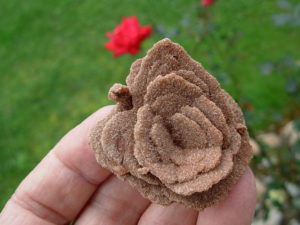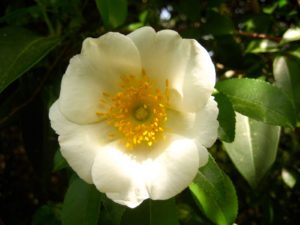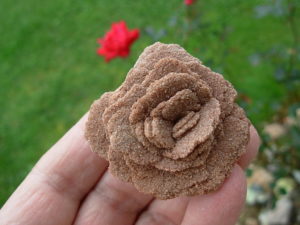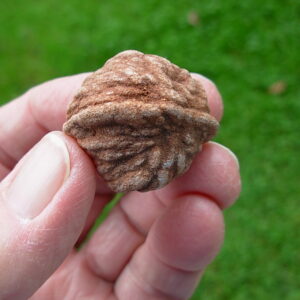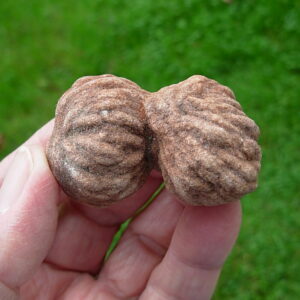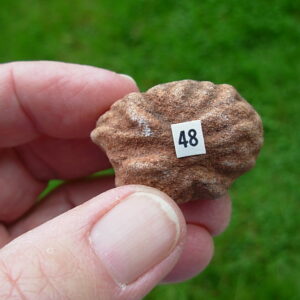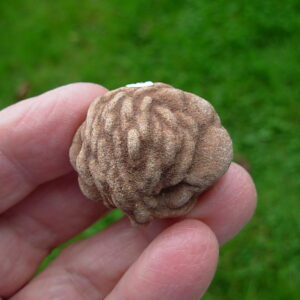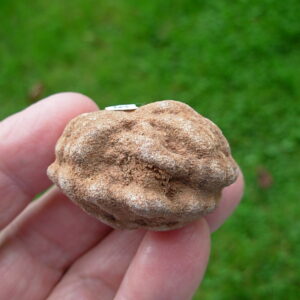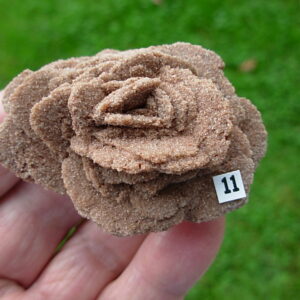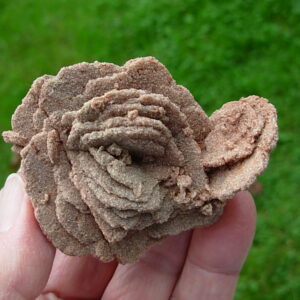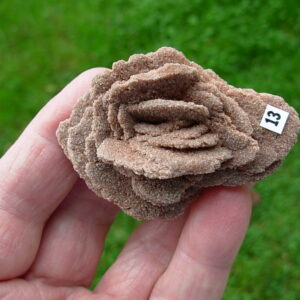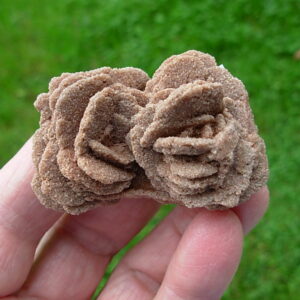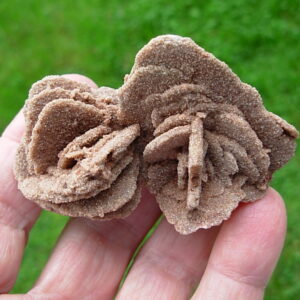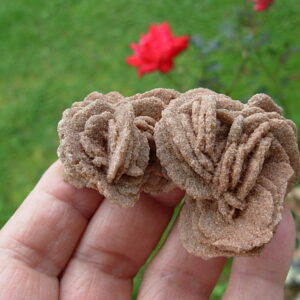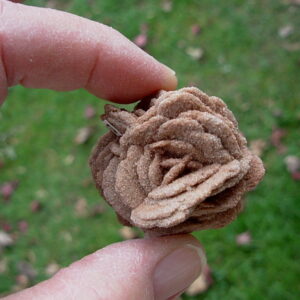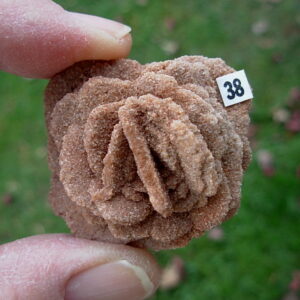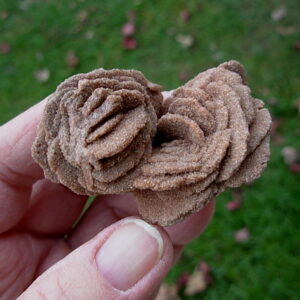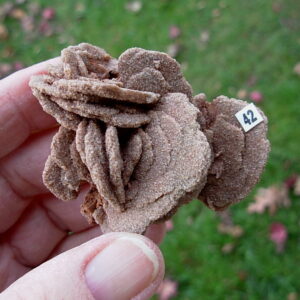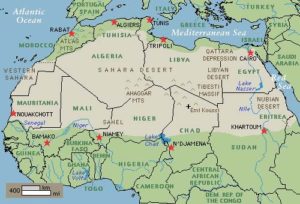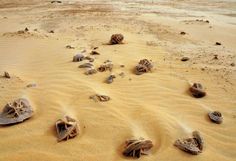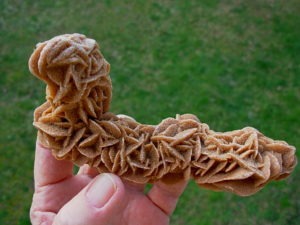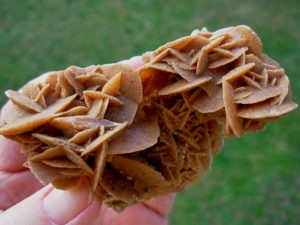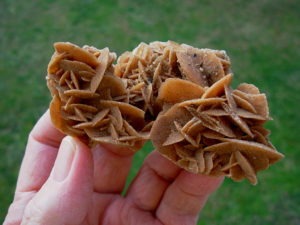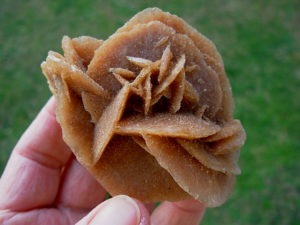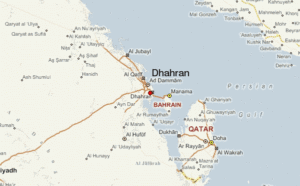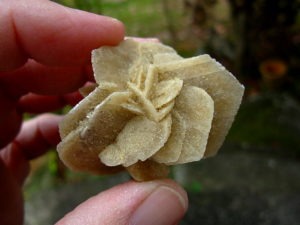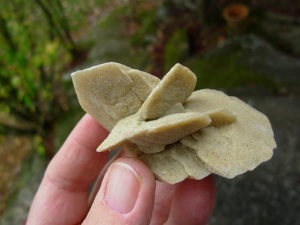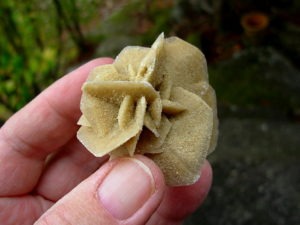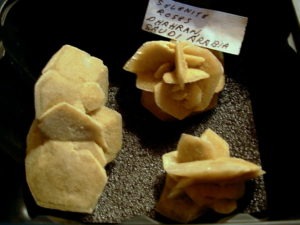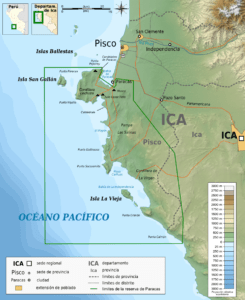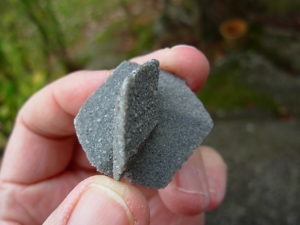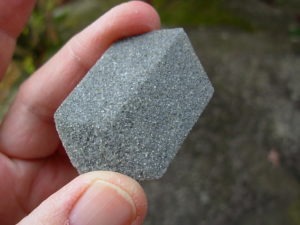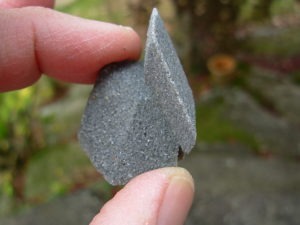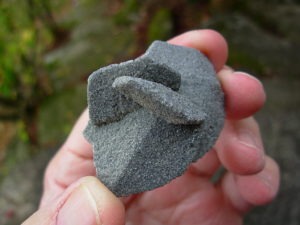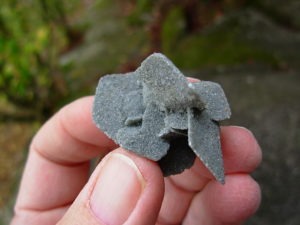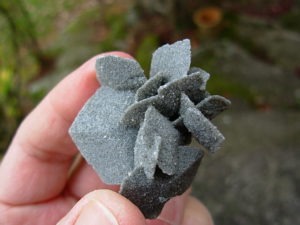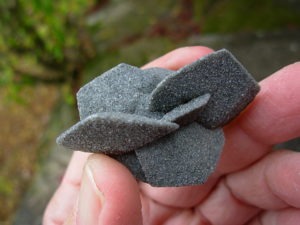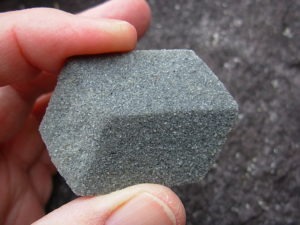Desert Rose
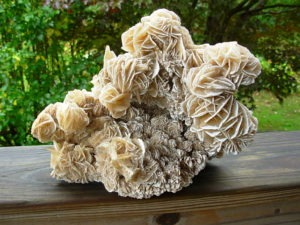
Selenite Desert Rose Mexico
Desert Rose is the name given to rosette formations of the minerals gypsum and barite with sand inclusions. The 'petals' are crystals flattened , fanning open along characteristic gypsum cleavage planes. The rosette crystal habit tends to occur when the crystals form in arid sandy conditions, such as the evaporation of a shallow salt basin.
Desert roses are mineral formations that are found on the surface and are beautiful examples of the natural power of the shaping forces of wind, water and pressure in dry, arid regions. These formations are also called Sand Roses, Rose Rocks, Selenite Roses, Gypsum Roses, and Barite Roses
Desert roses are crystal-like formations and may produce a rose shape, multiple plates adjoining at angles or the formations may look like a cluster of cereal flakes. They can look like flowers that have turned to stone. Native American stories told us that these were rocks carved into flowers by our ancestors to let us know they were here before us. Desert Roses take on the color of the sand because Selenite is a fibrous mineral and fine sand becomes trapped between the fibers as it crystallizes.
Desert roses form out of two minerals. One of those is Barite, which is the heavier of the two. The other is a type of Gypsum called Selenite. Selenite is the more fragile of the two. Gypsum (Selenite) roses usually have better defined, sharper edges than barite roses.
Desert roses are only found in deserts, which is how they got the name. Gypsum Selenite Desert Roses are mostly from the Sahara Middle East Region, Southwest USA and Mexico. The Barite Rose Rocks are more abundant in Oklahoma than anywhere else in the world and are the state rock of Oklahoma. Once these rock formations reach the surface, they are eroded quickly by the forces of wind and water. The quality of the specimen reflects how quickly it was collected. Larger multiple rosette specimens are always in demand and draw much higher prices.
Desert Roses from Mexico are found in the the Samalayuca Desert, Ahumada Municipality, Chihuahua, Mexico. Samalayuca is a small town on the Juarez-Chihuahua highway roughly 31 miles (50 km) south of El Paso-Juarez. Desert Roses are found in the old playa lake deposits. Many of these distinctive spherical aggregates with blades of tan-colored gypsum crystals, often heavily included with sand, have been found. Specimens may range from single rose formations, which may be up to 2.4 inches (6 cm) in diameter, to stunning clusters of multiple rose formations. These can be very large and heavy with fragile blade tips. Natural Selenite roses will develop white edges on the individual blades as they normally dehydrate from the desert sun. The white tips contrast nicely with the overall tan color of the gypsum. Specimens have been mined in Mexico for many years and have become a “must have” staple of our rock shop inventory.
-
Selenite Desert Rose 1 Very Rare “Butterfly Selenite Rose”
$49.00 Add to cart -
Selenite Desert Rose 6
$29.00 Add to cart -
Selenite Desert Rose 7
$19.00 Add to cart -
Selenite Desert Rose 9
$19.00 Add to cart -
Stunning Extra Large Gypsum Selenite Desert Rose Cluster From Mexico
$165.00 Add to cart -
Stunning Large Gypsum Selenite Desert Rose Cluster From Mexico
$135.00 Add to cart -
Stunning Large Gypsum Selenite Desert Rose from Mexico 4
$49.00 Add to cart
CHEROKEE ROSE LEGEND
In the 1800s, ignoring a decision in favor of the Cherokees Indians by the Supreme Court, President Andrew Jackson ordered the removal of the Cherokees and other Indian tribes from their Eastern homelands to be relocated in Oklahoma, a journey later referred to as the "TRAIL OF TEARS". About four thousand brave Cherokee people died on this arduous trip.
Indian folklore states that "God, looking down from heaven, decided to commemorate the courageous Cherokees. As the blood of the braves and the tears of the maidens fell to the ground, they were turned to stones in the shape of a rose." The Rose Rock is found in Oklahoma, the end of the journey.
When the Trail of Tears started in 1838, the mothers of the Cherokee were grieving and crying so much, they were unable to help their children survive the journey. The elders prayed for a sign that would lift the mother’s spirits to give them strength. The next day a beautiful rose began to grow where each of the mother’s tears fell. The rose is white for their tears; a gold center represents the gold taken from Cherokee lands, and seven leaves on each stem for the seven Cherokee clans. The wild Cherokee Rose grows along the route of the Trail of Tears into eastern Oklahoma today.
Source: The Cherokee 1994 Heritage Calendar by Dorothy Sullivan, Memoray Circle Studio, Norman, Ok.
Fun Fact... Old Timers who were Rock Collectors... ...used to call weather worn Barite Rose Rocks "Oklahoma Walnuts"
-
“Oklahoma Walnut” Barite Rose Rock 46
$10.00 Add to cart -
“Oklahoma Walnut” Barite Rose Rock 47
$15.00 Add to cart -
“Oklahoma Walnut” Barite Rose Rock 48
$10.00 Add to cart -
“Oklahoma Walnut” Barite Rose Rock 49
$10.00 Add to cart -
“Oklahoma Walnut” Barite Rose Rock 51
$10.00 Add to cart -
Barite Oklahoma Rose Rock 11
$19.00 Add to cart -
Barite Oklahoma Rose Rock 12
$20.00 Add to cart -
Barite Oklahoma Rose Rock 13
$20.00 Add to cart -
Barite Oklahoma Rose Rock 14
$26.00 Add to cart -
Barite Oklahoma Rose Rock 15
$17.00 Add to cart -
Exceptional Premium Barite Oklahoma Rose Rock
$24.00 Add to cart -
Exceptional Premium Barite Oklahoma Rose Rock 37
$22.00 Add to cart -
Exceptional Premium Barite Oklahoma Rose Rock 38
$22.00 Add to cart -
Exceptional Premium Barite Oklahoma Rose Rock 39
$27.95 Add to cart -
Exceptional Premium Barite Oklahoma Rose Rock 41
$42.95 Add to cart -
Exceptional Premium Barite Oklahoma Rose Rock 42
$22.00 Add to cart
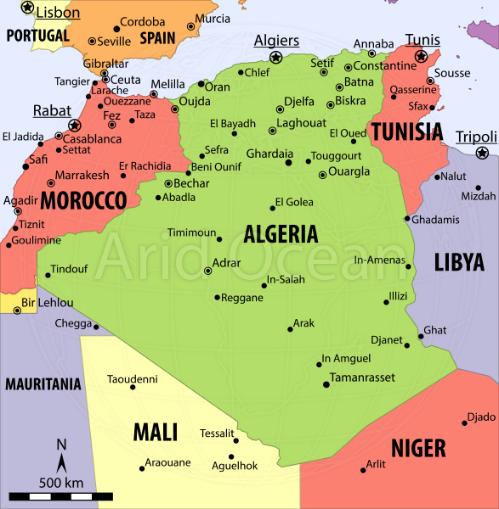
Desert Roses from the Algerian Desert
These natural Desert Rose stones were collected from Algeria Desert in the Oued Souf region, People's Democratic Republic of Algeria, which is a country in the Maghreb region of North Africa on the Mediterranean coast. We procured them direct from a mineral dealer in El Oued, Debila, People's Democratic Republic of Algeria, North Africa.
Desert Rose is the common name given to rosette formations of the minerals gypsum and barite with poikilotopic sand inclusions. (Poikilotopic [pȯi¦kil•ə¦täp•ik] is a geology term referring to the fabric of a crystalline sedimentary rock in which the component forming crystals are multisized and larger crystals enclose smaller crystals of another mineral. This is also known as poikilocrystallic.) The 'petals' are crystals flattened on the c crystallographic axis, fanning open along characteristic gypsum cleavage planes.
Each desert rose has a different and unique shape. It is impossible to find two desert roses in the world that will have identical shapes. These stones are formed with many geologic and climatic occurrences and changes. These stones can be up to 900 years old as found, and will continue to increase size, if left alone. These stones are really unique and reflect the natural beauty this world creates without any help or interference by mankind.
Western Sahara Desert of Morroco
The Desert Rose is also known as Sand Rose or Rose de Sable. These Desert Roses are gypsum crystals that grow from mineral rich ground water beneath the surface of the desert sand. They are from the Western Sahara Desert of southwestern Morocco. The sands in Algeria are light whitish-tan but the sands in the Western Sahara are an orangish-brown. The desert rose color is determined by the color of the surrounding sands which they form in.
Selenite Desert Roses from Dhahran, Saudi Arabia
Dhahran, (Arabic Al-Ẓahrān) is a town in northeastern Saudi Arabia. It is located in the Dammām oil field, just south of the Persian Gulf port of Al-Dammām and near the site of the original discovery of oil in Saudi Arabia in 1938. It now serves as the administrative headquarters of Saudi Aramco (Arabian American Oil Company).
A major U.S. Air Force installation (now King ʿAbd al-ʿAziz Base) was built there in 1945 under President Eisenhower, and a number of other U.S. military installations were later established in the area. It was one of the main marshaling and deployment points for U.S. troops during the Persian Gulf War. US forces have not been here since 2003.
We keep this information on our page for educational purposes for our customers. We are always looking for more specimens and they will be listed here when available.
Desert Roses from Peru
These amazing pieces are very rare collector specimens of Desert Rose Selenite from the Paracas Desert in Ica Department, Perú. These special pieces are rare deep green to grey display specimens of Paracas Desert Rose Selenites. Ica is a region (formerly known as a department) in Peru. It borders the Pacific Ocean on the west; the Lima Region on the north; the Huancavelica and Ayacucho regions on the east; and the Arequipa Region on the south. Its capital is the city of Ica. The Paracas National Reserve was created in 1975 and is located in Ica, Peru and consists of the Paracas Peninsula, coastal areas and tropical desert extending to the south slightly past Punta Caimán. Removing specimens from this area has been prohibited since the National Reserve was established. We were lucky to find a mineral dealer who had these specimens collected in the 1960’s. We keep this information on our page for educational purposes for our customers. We are always looking for more specimens and they will be listed here when available.

